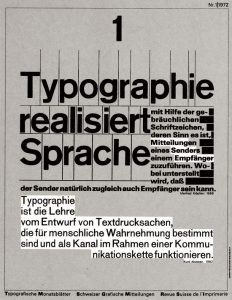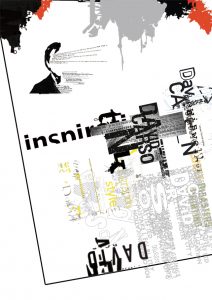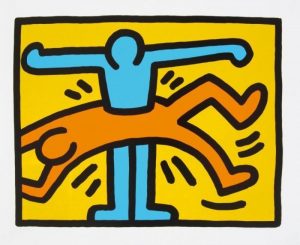 It is considered that the disorder or dissection is an important feature of postmodernism (Hassan). Wolfgang Weingart’ s artwork can totally show the characteristics of the postmodern art. The first image has many messy letters. It seems like the center of postmodernism, they are suspicious, negative and contradictory, they are also free. But if we watch the poster carefully, we can see the words are arranged in a particular order. The end of the letter is well arranged in a straight line, so that the color blocks formed by each word are arranged in a neat line, forming a line with no lines. For these reasons, he doesn’t use a line to limit and layout but the poster makes people feel neat.
It is considered that the disorder or dissection is an important feature of postmodernism (Hassan). Wolfgang Weingart’ s artwork can totally show the characteristics of the postmodern art. The first image has many messy letters. It seems like the center of postmodernism, they are suspicious, negative and contradictory, they are also free. But if we watch the poster carefully, we can see the words are arranged in a particular order. The end of the letter is well arranged in a straight line, so that the color blocks formed by each word are arranged in a neat line, forming a line with no lines. For these reasons, he doesn’t use a line to limit and layout but the poster makes people feel neat.
The second image is from David Carson. He has many artworks that are presented in a college. ”For artists, innovation may mean picking and picking from old things,” says Venturi. In fact, this is the basic creation method of postmodern architects. As well as designing posters, designers can collect different elements and put them in the artwork. Such as this poster from David Carson, we can see some photography which was cut out and some illustrates. The thing I like most is that he uses many different fonts, but the whole thing doesn’t feel very messy. The opposite, because of the appropriate superposition of different elements makes the poster look very layered and more abundant.
 I got the final picture from Keith Haring. His artworks
I got the final picture from Keith Haring. His artworks

often appear in lots of places, have a kind of intricate pattern, and the patterns are full of composition, often without perspective or texture, but with many symbolic feelings. I interested in the simple pattern, clean line and bright color in his artworks. He combines the characteristics of street art in his works. I like the movements of two people in this picture. It feels unrealistic, but it can stimulate my imagination. Thought the image is very simple and clean, it still expresses a rich emotion. The image is simple, people don’t need to think a lot
but also show the postmodernist characters, not depth, freedom, and pane.
Hassan, I. (1987). The postmodern turn essays in postmodern theory and culture.
Venturi, R. (1977). Complexity and contradiction in architecture (Vol. 1). The Museum of modern art.
